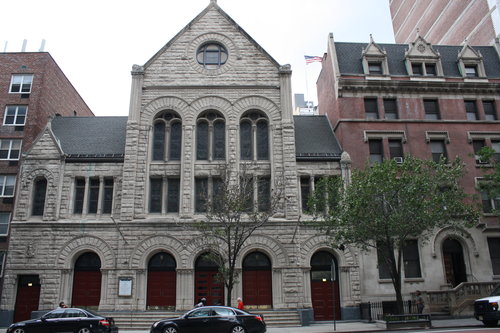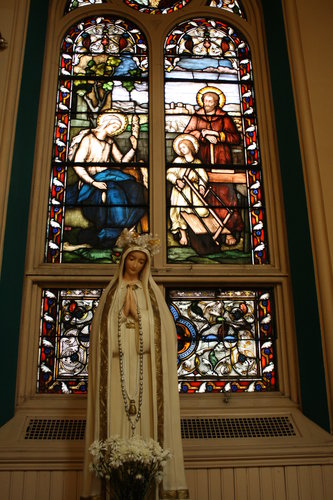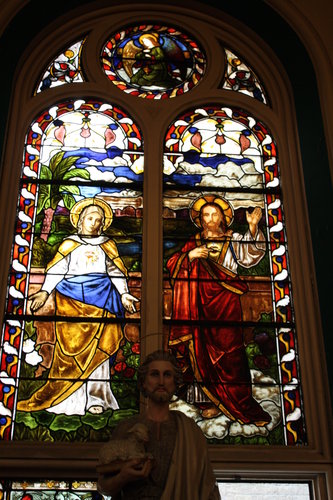Celebrate the Archangels in New York
A Visit to St. Michael the Archangel Church

Thousands of people who use Penn Station in Manhattan every day might not realize that, less than three blocks away, the Church of St. Michael the Archangel appeared in the neighborhood before Abraham Lincoln became president.
When the parish was formed in 1857 and the original edifice built, it stood on 31st Street, where Penn Station is now located.
In those days, the feast of St. Michael was celebrated on Sept. 29, the same as today. But after Vatican II, the liturgical calendar revision now has the powerhouse trio of archangels — Michael, Gabriel and Raphael — celebrated together on the late-September date.
Back in those days, as tons of Irish immigrants arrived at the nearby docks and lived in this area, the parish was bursting.
By 1876, more than 100 religious vocations came out of St. Michael’s. In 1883, the parish started a home for orphans and destitute children from the parish — St. Michael’s Home — on Staten Island, under the care of nuns, on the archangel’s feast day. In the half century the parish was associated with the home, it helped more than 2,000 children.
But in 1892, a devastating fire destroyed half of the church. By 1894, it was reconstructed with an Indiana-bluff limestone façade, along with 14 stained-glass windows from Munich and a main altar made of various colored marbles.
The parish grew in magnificent ways. By the mid-1890s, the school’s Holy Rosary Society numbered 165 members, who processed one Sunday a month, forming a 15-decade human Rosary.
On to Move
But in 1904 the Pennsylvania Railroad wanted the parish’s land, plus much housing around it, for the new tunnel and station. The church had to move.
Providentially, the move was just three blocks away, to its present site — the same distance to Madison Square Garden where Pope Francis said Mass last Friday.
In what involved a sort of exchange, the railroad agreed to buy a site picked by the pastor and build the present church and rectory, plus a convent and 1,700-student school, which are no longer there. The entire layout cost $1 million.
Architect Napoleon LeBrun, who designed the Cathedral-Basilica of Sts. Peter and Paul in Philadelphia, where Pope Francis offered Mass on Sept. 26, came aboard to design the new St. Michael’s.
As the church and other buildings went up between 1904 and 1907, three main elements from the earlier edifice became a part of the new St. Michael’s, offering a wonderful sense of continuity.
Before my wife, Mary, and I stepped foot into the church, we came face-to-face with the first element: The original Indiana-bluff stone façade, with its beautifully carved design, was disassembled, moved and reassembled, stone by stone.

The keystone on the face presents a relief of St. Michael defeating the devil. It carries these significant dates: 1857, 1892 and 1906.
Downs and Up Again
Back then, the parish was so large that eight to 10 priests filled the rectory. Then ups and downs began. Throughout the 1920s, parishioners dwindled as houses were cleared to make way for garment factories and lofts. Many faithful moved to places like Staten Island. Still, by 1938, the Miraculous Medal Novena was popular enough to be conducted three times a day at the parish.
In the 1940s, the church drew tourists from small hotels nearby and area workers, too. But as time rolled on after the Second World War, the neighborhood was desolate. Crime was taking its toll in the area, which was, and still is, known as Hell’s Kitchen. All the more reason St. Michael the Archangel is the church’s appropriate patron saint.
The nosedive continued, with crime infestation and blight coming with the downturn of the 1970s economy. Again, the neighborhood suffered, and parishioners declined.
But St. Michael’s, like its patron, could not be defeated.
Revitalization
In recent years, the area started a big revitalization. Father George Rutler, who has hosted various television series on EWTN for 28 years, told us that when he arrived as pastor in 2013 Sunday Mass was held in the chapel, not the main church, because so few people attended.
But soon, more people showed up.
Sunday Mass and one daily Mass were again celebrated in the main body of St. Michael’s.
And, to date, collections have gone up five times.
This is a happy turn, indeed, for a church said to have the largest seating capacity of any diocesan church in the city outside of St. Patrick’s Cathedral and St. Paul the Apostle Church.
Something Old, Something New
When Mary and I first stepped into the church, what a welcome at the back of the nave: To the left side, a life-size statue of our Blessed Mother as the Immaculate Conception, with extended arms, greets the faithful. Nearby, a larger-than-life-size St. Michael, with his sword upraised, defeats the devil.
Past the standing carved angels that hold bowls of holy water, we walked down the long center aisle, alongside the Roman arches and stained-glass windows lining the nave to the sanctuary.
The 1907 parishioners surely were comforted seeing the second element saved from the 1894 church — the original altar — and the third element too: 14 stained-glass windows that now embrace them in a huge “hug.”
Among them: the Betrothal of Joseph and Mary, St. Anne with Mary, the Holy Family in Joseph’s workshop, the Nativity, the Wedding at Cana, the Resurrection and, standing side-by-side, the Sacred Heart and Immaculate Heart of Mary.
Exceptionally large oil paintings of the Stations of the Cross fill the spaces between the windows, and several statues along the side aisles tell us of the faithful’s devotions.
The original Communion railings line the front of the sanctuary, with its original multi-hued marble altar. Father Rutler had the original reredos of dark wood magnificently gilded. He learned the technique from his father and in turn taught it to St. Michael’s parishioners and Ken Woo, an artist who does incredible religious icons, and his wife. They all worked on completing this extensive, stunning gilding.
The ornately carved reredos now glistens in gold. The tabernacle is central. Above it is a crucifix, and, directly above both, golden statues present our Blessed Mother kneeling in adoration as an angel with huge golden wings stands protectively at her side. Straight up at the pinnacle, a shrine honors Christ the King.
This reredos gives a “mini” catechism for contemplation that includes the Four Evangelists presented in beautifully carved images in individual shrine alcoves, each rising into tall, gilded spires carved in lace-like intricacy.
Along three sides of the sanctuary, gilded angels holding their torches high stand above golden letters that spell out: “Lamb of God Who / Takest Away the Sins of the World / Grant Us Peace.” The prayer stretches toward both side shrine altars to Our Lady and St. Joseph with the Child Jesus.


Looking Ahead
Now, the Divine Mercy Chapel, which was the original baptistery, holds the early daily Mass and has reminders of St. John Paul II, St. Faustina and, of course, Jesus the Divine Mercy.
Only the Lord knows the future, but St. Michael’s appears on the rise again. Father Rutler noted a lot of tourists stop by to see its beauty — and to say a prayer.
And the area is further revitalizing, with the Hudson Yards, the largest private real estate development in New York City’s history and largest since Rockefeller Center in the 1930s. With high-rise offices, 5,000 residences and shops, it expects 65,000 newcomers.
The day we visited, a young couple and their family were preparing for the baptism of their son, proof St. Michael’s is again growing.
Joseph Pronechen is the Register's staff writer.
INFORMATION
Visit StMichaelNYC.com; check website for Mass schedule.

















